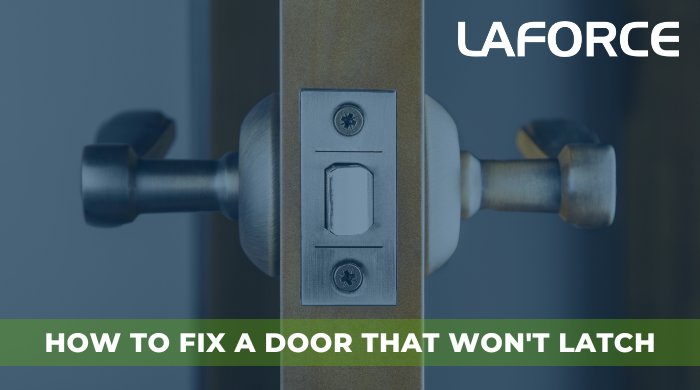
Your door latch can become stubborn for a variety of reasons—warped frames, misaligned latches, or even simple wear and tear. Whether you have a traditional knob, lever, or a more modern latch, understanding the mechanics behind it can help simplify the solution. In this guide, I’ll walk you through how to identify the problem and how to fix it, so you can get that door closing smoothly with just a gentle nudge.
Understanding the Anatomy of Your Door Latch
Before diving into troubleshooting, it helps to know a bit about how door latches work. A door latch is designed to keep the door closed and secure. It consists of a latch bolt, which is the part that moves in and out, and a strike plate, which is attached to the door frame. When you close the door, the latch engages with the strike plate, keeping the door in place.
Imagine the latch as a tiny gatekeeper. It needs to slide smoothly into the strike plate to do its job right. If anything interferes with this sliding action—like misalignment or debris—it can cause you to struggle when closing the door. So, if you find yourself pushing harder than necessary to close the door, there’s a good chance something’s off in this simple mechanical system.
Common Causes of a Stubborn Door Latch
There are several reasons why your door latch might be requiring that extra shove. Here are some common culprits:
- Misalignment: Over time, door frames can shift, causing the latch to miss the strike plate.
- Wear and Tear: Regular use can wear out the latch mechanism, causing it to stick.
- Debris Buildup: Dust or debris can collect in the latch area, obstructing movement.
- Humidity Changes: Wood can expand during humid weather, which may affect door alignment.
Identifying the exact cause is crucial. For instance, if you notice your door sticks more in certain weather conditions, humidity may be the issue. Alternatively, if the door used to close smoothly but has become difficult, then wear and tear or misalignment could be at play.
How to Diagnose the Problem
Diagnosing the issue doesn’t require a degree in engineering. Start by visually inspecting your door and latch. Here’s a simple way to check:
1. Close the Door Slowly: Watch how the latch meets the strike plate. Is it missing it entirely, barely catching, or is it jamming?
2. Check for Gaps: Look for any gaps between the door and the frame when closed. This could indicate misalignment.
3. Feel for Resistance: When you attempt to latch the door, feel if there’s too much resistance or if it doesn’t catch at all.
If you can identify any of these indicators, you’re halfway there! Next, you’ll need to take some action based on your findings.
Adjusting the Door Latch for Alignment
If the problem lies in misalignment, you can often fix this without much hassle. Here’s how:
1. Loosen the Hinges: Use a screwdriver to gently loosen the screws on the door hinges. You don’t need to remove them—just loosen them enough to allow movement.
2. Shift the Door: Carefully push the door either toward or away from the frame until the latch aligns properly with the strike plate.
3. Retighten the Screws: Once you have the door in the right position, retighten the screws on the hinges to secure it in place.
This adjustment can make all the difference. It’s like giving a friend a nudge at the right moment to help them fit into a tight space.
Cleaning the Latch Mechanism
Debris buildup can also lead to a stubborn latch. Cleaning the latch can restore its functionality. Here’s a quick guide:
1. Remove the Latch Plate: Using a screwdriver, remove the screws holding the latch plate in place.
2. Clean with a Brush: Use a small brush or cloth to clean any dirt or dust around the latch area.
3. Lubricate the Mechanism: Apply a few drops of lubricant to the moving parts of the latch.
4. Reattach the Plate: Once everything is clean and lubricated, put the latch plate back in place and test it out.
A clean latch is like a well-oiled machine—it works smoothly and efficiently.
When to Replace the Door Latch
If you’ve tried adjusting and cleaning but still find that your door latch requires excessive force, it might be time for a replacement. Here are some signs it’s time to buy a new latch:
- Visible Damage: If the latch or bolt is bent or cracked, it won’t function correctly.
- Inconsistent Performance: If the latch occasionally sticks, it’s a sign of wear that cleaning can’t fix.
- Old Age: If your latch is several years old, newer models might offer better performance and security.
Replacing a latch isn’t too difficult, and many options are available in home improvement stores. Look for the right size and style that fits your door for a smooth swap.
Dealing with a door latch that requires force to close can be frustrating, but most issues have simple solutions. By understanding the mechanics, diagnosing the problem, and taking appropriate action, you can often fix the problem yourself.
Remember, a well-functioning door latch is important for both convenience and security. Whether adjusting, cleaning, or replacing, addressing the issue early can save you from future headaches. So, the next time you find yourself wrestling with a stubborn door, you’ll be ready to tackle it like a pro!